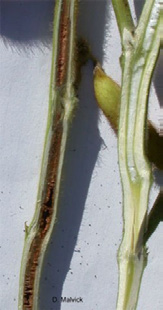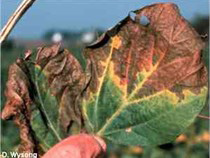
May 22, 2020, 9:00 AM
Brown Stem Rot in Soybeans
Many soybean growers in the Upper Midwest face annual challenges to soybean production. Brown Stem Rot (BSR) is an economically important disease and is the result of the soil-borne fungus Phialophora gregata [2] that affects the inner stem of soybean plants. It may not be visible without splitting stems open on the infected plants [1]. BSR can cause significant yield loss and can also cause premature senescence of the infected plants [1], leading the soybeans to mature faster than what the relative maturity indicates. This disease is often misidentified as Sudden Death Syndrome (SDS), as the leaf symptoms in the reproduction phase can be similar.
 |
| Picture 1 [1] Photo credit: University of Minnesota Extension |
 |
| Picture 2 [4] Photo credit: University of Nebraska-Lincoln |
Picture #1 is of two split soybean stems, the one on the left has BSR noted by the dark discoloration of the pith and the one on the right is infected with SDS and has white/clear pith. Picture #2 shows BSR leaf symptomology:
Factors to Consider:
- Infection timing: The BSR fungus infects the soybeans early in the growing season. Planting earlier than normal or on-time even into good soil conditions can enhance the probability of BSR infection.
- Symptoms: Symptoms typically do not show up until the reproduction stages (R3-R4) preceded by cool, wet conditions during pod-fill [2]. A period of hot and dry weather after pod fill may enhance the disease's ability to spread [1].
- Soybean Cyst Nematodes (SCN): SCN pressure may increase the chances of BSR infection due to the tiny entrance wounds the nematodes produce early on in the root system, thus increasing the chances of the BSR fungus entering the roots.
- Fertility: Low fertility fields can increase the severity of the disease [2].
Action Plan:
Since there are no chemical controls for Brown Stem Rot, here are a few management practices that can be used to minimize the potential of infection:
- Variety selection: If BSR is known to be a problem and the field is planted into soybeans, choose an appropriate variety(s). There are varieties on the market that are either resistant or highly tolerant to BSR [4]. This is the best defense against the disease.
- Crop rotation: Be sure to rotate varieties to maintain effectiveness of the resistance gene [4]. In fields known to have severe BSR infection, it’s best to rotate out of soybeans for at least three years This allows time for the infected residue to break down since the pathogen cannot live outside of its host crop.
- Tillage: Tillage can also be an effective control measure to bury residue and speed up the decomposition of the infected residue.
Summary:
Brown Stem Rot is a disease in soybeans that can cause yield loss without many visual symptoms. Often mistaken with SDS, BSR is best identified by splitting stems open to look for a browning in the stem pith. BSR can cause significant yield losses up to 30%. Even plants that show no leaf symptoms can have yields reduced by 5-15% [1]. Although not as widespread as SDS across the Midwest, BSR can be a silent yield robber for soybean producers across the Upper Midwest given the right conditions. Keeping good field history notes and choosing resistant varieties for known infected fields is the best management practice at this time.
Resources:
- Brown Stem Rot (BSR) on soybean extension.umn.edu/pest-management/brown-stem-rot-bsr-soybean
- “Diseases of Soybean” Brown Stem Rot extension.purdue.edu/extmedia/BP/BP-41-W.pdf
- Be on the Lookout for Brown Stem Rot in Soybeans crops.extension.iastate.edu/cropnews/2014/08/be-lookout-brown-stem-rot-soybean
- Brown Stem Rot cropwatch.unl.edu/plantdisease/soybean/brown-stem-rot

